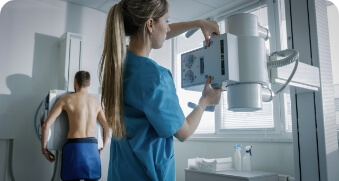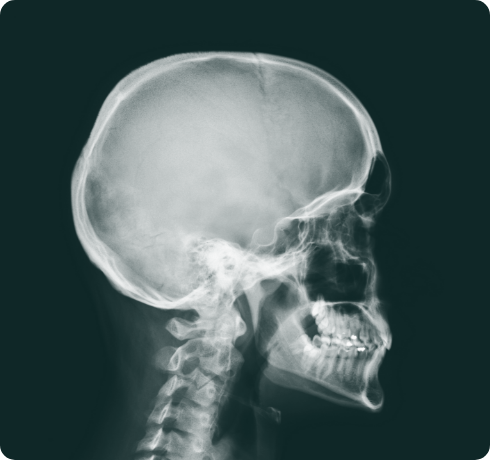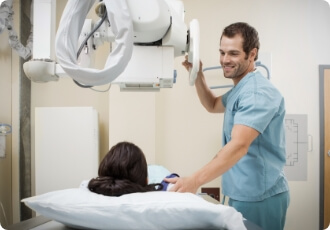
What to consider when deciding on a Virtual Reality (VR) system for training purposes

With increasing pressures on budgets and limited availability of training facilities and clinical placements, Virtual reality (VR) simulation training has been welcomed by medical educators as a cost-effective, accessible and engaging way for students to practice clinical skills in a risk-free environment.
VR simulation training provides engaging and realistic first-person immersion that helps students to connect knowledge with experience. In addition to providing cost-saving, risk-free skills practice, VR makes learning fun, builds confidence, can be carried out autonomously, and requires very few resources compared with traditional clinical skills training methods. Plus, it provides a standardised and objective means of skills assessment.
As an emerging technology, however, there remains some uncertainty around what to look for when selecting a VR system for training purposes. In this article, we’ll look at a few important criteria to consider when selecting your VR training system.
A quick introduction to VR technology
For those new to VR, we’ll take a moment to introduce the basic set-up here. VR technology uses 3D-generated images projected onto a screen set into a special headset to give the viewer the sensation of being transported into the simulated environment. Rather than watching something on a screen, the VR user feels like they are actually there inside the virtual world.
VR hardware configurations
There are three main hardware configurations commonly used in VR. They are:
- Mobile VR where the user inserts their mobile phone into the VR headset.
- Standalone VR where the headset does not require any additional devices or cables to run the simulation.
- Desktop where the VR experience is powered by high-end computers in addition to the headset.
The choice of configuration will depend on the type of training you’re doing. Flight simulators, for example, require complex hardware configurations; however, mobile or standalone headsets work well for most training applications.
Mobile VR headsets
Smartphone-based VR headsets are widely used as they are easily accessible and comparatively inexpensive. They use the smartphone’s existing features to create the virtual world. Users simply install an app onto their phones, pop the phone into the specially designed headset and they’re ready to go.
Standalone VR headsets
As the name implies, standalone headsets have everything necessary to create and run a VR simulation built into the headset. This includes a screen, gyroscope, dedicated controls and earphones all in a single device.
In the past, these headsets were notoriously bulky. One of the earlier ones even weighed so much, it had to be suspended from the ceiling using metal rods (take a look at our article on the history of VR for more fun facts). Modern standalone headsets are far more practical, versatile and economical than their clumsy predecessors, and they are rapidly gaining ground in the education sector.
A scalable, flexible platform
Scalability and flexibility are vital to keep costs down. Choose a license-based software platform that allows you to purchase extension packages as required so that you can scale your costs according to your needs, allowing for fluctuations in intake and changes to requirements.
Ideally, your VR platform should be sufficiently flexible to facilitate both individual and paired classroom-based simulation and also extend to whole class lecture-style demonstrations or large-screen group-based learning with all the collaborative learning benefits that this brings.
High levels of fidelity (realism)
The value of experiential learning has long been acknowledged, as this saying attributed to Confucius indicates: “I hear and I forget. I see and I remember. I do and I understand.”
VR takes students on an experiential learning journey, and it stands to reason that the more realistic the experience offered by VR, the more effective the learning will be.
In fact, there is a strong connection between functional and physical fidelity (realism) and the transfer of skills. This is why it is important to choose a VR system that uses cutting edge visualisation software, placing users in a virtual environment that is as realistic as possible.
Accurate spatial relationships in 3D simulated environments
The use of 3D visualisation is strongly indicated for training in processes that require understanding and application of 3D relations, such as medical imaging simulation where the 3D challenge requires the clinician to position the patient and equipment in three dimensions.
Software that delivers an accurate spatial relationship is essential for appropriate training in such circumstances. The use of accurate 3D technology allows students to visualise these complex 3D spatial relationships and to move away from the limitations of a 2D computer screen.
Intuitive controls
It goes without saying that VR software should be user-friendly with intuitive controls to make the learning process enjoyable and engaging.
Rather than rely on a complicated menu system, users should be able to simply click on the appropriate area of the equipment and then control it in the same way they would control the real-life equipment. This makes for a rapid learning curve and maintains high levels of realism and interactivity.
Realistic environmental constraints
The degree to which the student can manipulate or control the environment should reflect the limitations and possibilities they will encounter in real-life situations. For example, when entering an operating theatre, trainee radiographers will have no control over the initial environment or patient position, as the patient will be positioned according to surgical procedure requirements. They must learn to position C-Arms and monitors appropriately in order to get the required images. VR simulation protocols should be set up to mimic these limitations so that students learn to carry out the necessary procedures within the constraints of the environment.
System administration options
Choose a system which enables tutors to create “standard” setups and images that can be tailored to local practice while operating in as unrestricted a manner as possible.
Ideally, the software should allow unlimited standard setups to be created and saved as a protocol for students to work towards. This process should be rapid and simple, making initial setup straightforward. Additionally, users should be able to interact with all modules “off-protocol” and experiment with the environment.
The latter function is especially useful if you plan on using the software to attract students at recruitment and marketing events where prospective students are able to “play” with the software while gaining an understanding of the medical workplace.
Wide ranging simulation options
Choose a product that will grow with your institution and provide high quality virtual environment simulation to as wide a range of learners as you wish. Selecting a platform that offers users a wide range of environments in which to hone their skills and which facilitates creation of an unlimited variety of protocols and procedures, will make your VR simulation training program even more cost-effective.
A VR platform that is designed to be tailored to individual institutional requirements and to be used throughout the full range of the learning journey will ensure the widest possible usage of the resource across a range of disciplines.
VR software that encourages process learning
This is particularly important when software is being used for pre-clinical technique preparation where it is vital that users are able to engage with the software as if it were a real clinical machine.
An essential component of process learning is provision of engaging feedback, and your chosen platform should respond realistically so that poor technique on the part of the student leads to poor results.
The best software platforms allow educators to develop their own range of technique protocols and standards, so users are able to review their results against set standards.
Software packages should include a feature where the software will animate the differences and indicate specific changes that need to be implemented to improve the student’s technique in future.
An active support community
Choose a package that allows for full personalisation of all protocols to ensure learning matches specific local procedures and techniques and where support does not end after purchase.
Online communities provide a valuable forum for resource-sharing, collaboration and mutual support and actively encourage distribution of teaching resources, nurturing collaborative research and development.
A community that includes active involvement from the software facilitators and development team will ensure that client queries and suggestions are responded to rapidly.
Future proof
With health and visualisation technologies constantly changing, it is vital that simulation resources are able to not only reflect the most up-to-date clinical changes, but also engage users with cutting-edge learning environments.
Make sure you are not just getting a static simulation resource, but also a commitment to facilitate learning using the absolute latest visualisation technology.
Look for a software provider set to maintain its position at the bleeding edge of technological innovation, so your students and users will benefit from increasing realism and levels of interactivity.
If you would like to find out more about our medical imaging virtual reality training environments that tick all the boxes, please reach out to our friendly team today.
Check Out More Articles

Let use medspace.VR give you that advantage
Whether you are an institution or a student, medspace.VR is designed to help. Begin the process today.
Enquire Now


